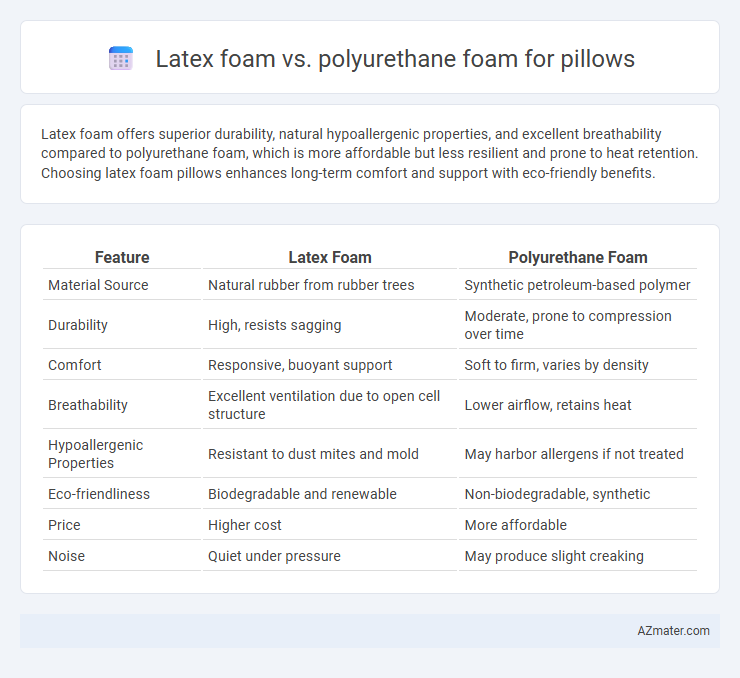Latex foam offers superior durability, natural hypoallergenic properties, and excellent breathability compared to polyurethane foam, which is more affordable but less resilient and prone to heat retention. Choosing latex foam pillows enhances long-term comfort and support with eco-friendly benefits.
Table of Comparison
| Feature | Latex Foam | Polyurethane Foam |
|---|---|---|
| Material Source | Natural rubber from rubber trees | Synthetic petroleum-based polymer |
| Durability | High, resists sagging | Moderate, prone to compression over time |
| Comfort | Responsive, buoyant support | Soft to firm, varies by density |
| Breathability | Excellent ventilation due to open cell structure | Lower airflow, retains heat |
| Hypoallergenic Properties | Resistant to dust mites and mold | May harbor allergens if not treated |
| Eco-friendliness | Biodegradable and renewable | Non-biodegradable, synthetic |
| Price | Higher cost | More affordable |
| Noise | Quiet under pressure | May produce slight creaking |
Introduction to Pillow Foam Materials
Latex foam and polyurethane foam are two common materials used in pillow production, each offering distinct comfort and support characteristics. Latex foam, derived from natural rubber or synthetic sources, provides buoyant support with excellent durability and hypoallergenic properties, making it ideal for allergy sufferers. Polyurethane foam, a versatile synthetic material, is widely utilized for its affordability and customizable firmness but typically offers less breathability and longevity compared to latex foam.
What is Latex Foam?
Latex foam is a natural or synthetic material derived from rubber tree sap, known for its durability, breathability, and resilience in pillows. It offers excellent support by contouring to the head and neck while maintaining shape, making it ideal for pressure relief and spinal alignment. Latex foam pillows are also hypoallergenic, resistant to dust mites, and provide superior ventilation compared to traditional polyurethane foam.
What is Polyurethane Foam?
Polyurethane foam is a versatile synthetic material widely used in pillows for its affordability, lightweight properties, and ability to provide varying levels of firmness and support. It is made through a chemical reaction between polyols and diisocyanates, resulting in a flexible foam that can be engineered to different densities and resilience levels. Unlike latex foam, polyurethane foam typically offers less durability and breathability, making it a common choice for budget-conscious consumers seeking comfortable and supportive sleep surfaces.
Key Differences Between Latex and Polyurethane Foam
Latex foam offers superior natural elasticity and durability compared to polyurethane foam, which tends to compress and lose shape faster over time. Latex foam is hypoallergenic and resistant to dust mites, providing better breathability and moisture-wicking properties, whereas polyurethane foam may trap heat and allergens. The key differences in material composition, resilience, and breathability make latex foam a premium choice for pillows demanding longevity and comfort.
Comfort and Support Comparison
Latex foam pillows offer superior support and pressure relief due to their natural resilience and ability to conform closely to the head and neck, promoting spinal alignment. Polyurethane foam pillows provide varying firmness levels but often lack the durability and breathability of latex, potentially leading to faster breakdown and heat retention. For optimal comfort, latex foam is preferred for its hypoallergenic properties and consistent support, while polyurethane foam may suit budget-conscious consumers seeking softer cushioning.
Durability and Longevity
Latex foam pillows offer superior durability and longevity due to their natural resilience and ability to retain shape over time, often lasting up to 8-10 years without significant degradation. Polyurethane foam, especially memory foam variants, tends to compress and lose support after 2-5 years, leading to decreased comfort and increased wear. The inherent elasticity and resistance to sagging in latex foam make it a long-lasting choice for maintaining consistent support and comfort.
Hypoallergenic and Health Considerations
Latex foam pillows are naturally hypoallergenic, resistant to dust mites, mold, and bacteria, making them ideal for individuals with allergies or asthma. Polyurethane foam pillows, while offering support and shape retention, may off-gas volatile organic compounds (VOCs) that can cause respiratory irritation in sensitive users. Choosing latex foam reduces exposure to allergens and chemical irritants, promoting healthier sleep environments.
Environmental Impact of Latex vs Polyurethane Foam
Natural latex foam, derived from rubber tree sap, is biodegradable and renewable, offering a significantly lower environmental footprint compared to petroleum-based polyurethane foam. Polyurethane foam production involves petrochemicals that emit higher levels of volatile organic compounds (VOCs) and contribute to non-biodegradable landfill waste. Choosing latex foam supports sustainable forestry practices and reduces reliance on fossil fuels, making it the eco-friendlier choice for pillows.
Price and Value Analysis
Latex foam pillows typically cost more, ranging from $50 to $150, due to their natural materials and durability, while polyurethane foam options are cheaper, often between $10 and $50, offering budget-friendly comfort. Latex foam provides superior resilience, breathability, and hypoallergenic properties, enhancing long-term value despite the higher upfront investment. Polyurethane foam pillows may compress faster and retain heat, which can reduce overall comfort and lifespan compared to latex alternatives.
Which Pillow Foam is Best for You?
Latex foam pillows offer superior durability, natural hypoallergenic properties, and excellent support by contouring to the head and neck, ideal for those seeking pressure relief and eco-friendly materials. Polyurethane foam pillows, often referred to as memory foam, provide high-density support with good motion isolation and affordability, suitable for individuals needing firm support and pain relief from neck stiffness. Choosing the best pillow foam depends on your preferences for breathability, firmness, and sensitivity to allergens, with latex favoring natural resilience and polyfoam delivering customizable comfort.

Infographic: Latex foam vs Polyurethane foam for Pillow
 azmater.com
azmater.com